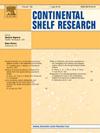Flow characterization and turbulence in the eastern section of the Strait of Magellan, Southern Chile
IF 2.1
3区 地球科学
Q2 OCEANOGRAPHY
引用次数: 0
Abstract
The Strait of Magellan connects the Pacific and Atlantic oceans in South America’s southern region, and it has been recognized for centuries as an important transoceanic navigation route as well as a unique marine environment with a rich ecological diversity. Evaluations of the impact of human activities in the channel and multiple potential future developments require a better understanding of the physical environment to design sustainable strategies aimed at preserving these characteristics. In this investigation, we study the flow near the Atlantic inlet of the Strait where the dynamics is characterized by the interactions of the tide propagation within two narrows, which are the predominant features of the channel morphology. Tides amplified by the Patagonian shelf generate strong currents through these narrows and control the exchange between the Atlantic and central regions of the Strait. We employ bottom-mounted and vessel-mounted Acoustic Doppler Current Profilers (ADCPs) with tide gauges to analyze the mean flow, tidal propagation, and turbulence, complementing the data with previous available measurements. The analysis reveals residual flows directed toward ebb flow at the channel center and flood near the edges, showing a significant spring-neap variation. Turbulence statistics in the second narrows exhibit a significant variability between ebb and flood, with a balance between production and dissipation observed only during ebb phases.
智利南部麦哲伦海峡东段的水流特征和湍流情况
麦哲伦海峡位于南美洲南部地区,连接太平洋和大西洋,数百年来一直被认为是重要的跨洋航道,也是具有丰富生态多样性的独特海洋环境。要评估人类活动对航道的影响以及未来的多种潜在发展,就必须更好地了解物理环境,以设计旨在保护这些特征的可持续战略。在这项调查中,我们研究了海峡大西洋入口附近的水流,其动态特征是潮汐在两个狭长地带内传播的相互作用,这是海峡形态的主要特征。经巴塔哥尼亚大陆架放大的潮汐通过这些狭窄处产生强大的水流,控制着海峡大西洋和中部地区之间的水流交换。我们利用安装在海底和船上的声学多普勒海流剖面仪(ADCP)和验潮仪来分析平均流、潮汐传播和湍流,并将这些数据与之前的测量数据进行补充。分析结果显示,残余水流在水道中心为退潮流,在边缘为洪峰流,显示出显著的春-夏变化。第二窄河道的湍流统计在退潮和洪水之间表现出明显的变化,只有在退潮阶段才能观察到产生和消散之间的平衡。
本文章由计算机程序翻译,如有差异,请以英文原文为准。
求助全文
约1分钟内获得全文
求助全文
来源期刊

Continental Shelf Research
地学-海洋学
CiteScore
4.30
自引率
4.30%
发文量
136
审稿时长
6.1 months
期刊介绍:
Continental Shelf Research publishes articles dealing with the biological, chemical, geological and physical oceanography of the shallow marine environment, from coastal and estuarine waters out to the shelf break. The continental shelf is a critical environment within the land-ocean continuum, and many processes, functions and problems in the continental shelf are driven by terrestrial inputs transported through the rivers and estuaries to the coastal and continental shelf areas. Manuscripts that deal with these topics must make a clear link to the continental shelf. Examples of research areas include:
Physical sedimentology and geomorphology
Geochemistry of the coastal ocean (inorganic and organic)
Marine environment and anthropogenic effects
Interaction of physical dynamics with natural and manmade shoreline features
Benthic, phytoplankton and zooplankton ecology
Coastal water and sediment quality, and ecosystem health
Benthic-pelagic coupling (physical and biogeochemical)
Interactions between physical dynamics (waves, currents, mixing, etc.) and biogeochemical cycles
Estuarine, coastal and shelf sea modelling and process studies.
 求助内容:
求助内容: 应助结果提醒方式:
应助结果提醒方式:


